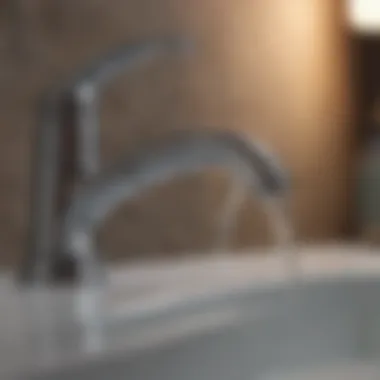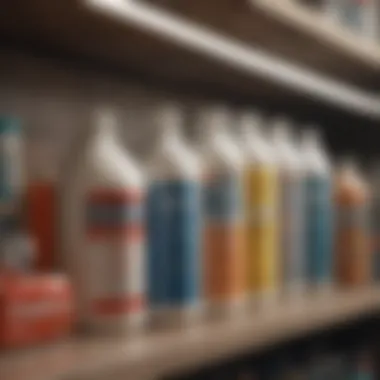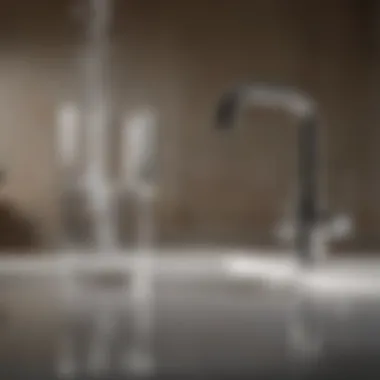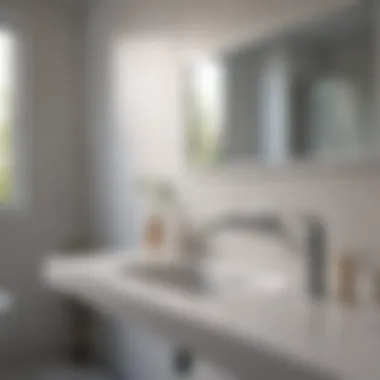The Ultimate Guide to Hard Water Calcium Removers


Intro
Hard water presents a myriad of challenges for homeowners. Calcium buildup from hard water clogs pipes, adds wear to appliances, and diminishes the aesthetic appeal of fixtures. A comprehensive understanding of how to effectively manage and remove this buildup is not only crucial for maintaining plumbing systems but also enhances the overall impression of one's living space.
In this guide, we will explore various methods and products for calcium removal. The focus is not just on immediate solutions but also on ongoing maintenance strategies to extend the lifespan of plumbing infrastructure.
By delving into both commercial products and DIY solutions, readers will gain valuable insight regardless of their budget or technical skills. This guide aims to arm homeowners and design enthusiasts with the information required to tackle hard water issues head-on, preserving the integrity and appearance of their homes.
Understanding Hard Water and Its Effects
Understanding hard water is essential in addressing its implications on household maintenance and overall efficiency. Hard water contains high levels of minerals, primarily calcium and magnesium. These minerals can accumulate over time, leading to several unwanted effects in homes. By recognizing the effects of hard water, homeowners can take proactive measures to minimize its impact, avoiding extensive repairs and increasing the lifespan of their plumbing systems and appliances.
Definition of Hard Water
Hard water is commonly defined as water that has high mineral content, specifically calcium and magnesium ions. This mineralization occurs as water moves through soil and rock, picking up these elements. The primary measure of hardness is expressed in grains per gallon (GPG) or parts per million (PPM). Water that exceeds 7 GPG or 120 PPM is typically labeled hard. Understanding this definition helps homeowners identify the water quality they have and appropriately respond to its effects.
How Hard Water Affects Your Home
Analyzing how hard water impacts your home is crucial for maintaining a safe and functional living environment. Its repercussions are tangible across various domains:
Impact on Plumbing Systems
Hard water contributes to the gradual accumulation of limescale in plumbing systems. Limescale buildup can obstruct pipes, leading to reduced water flow, higher pressure, and ultimately, pipe bursts. Homeowners may find themselves needing to replace their plumbing sooner than expected, resulting in significant costs. Thus, understanding the potential consequences of hard water on plumbing allows for better long-term planning and preventive actions.
Effects on Appliances
Appliances, such as dishwashers and washing machines, are also susceptible to hard water issues. Mineral deposits can significantly reduce their effectiveness over time. For instance, a buildup in a dishwasher may result in poor cleaning performance and hasten the need for repairs or replacements. Recognizing the impact of hard water on appliances underscores the necessity for regular maintenance and appropriate care to prolong their lifespan and efficiency.
Consequences for Fixtures
Calcium and magnesium deposits appear on various fixtures, including faucets and showerheads. These deposits can create unsightly stains and impede the even flow of water. This not only affects the aesthetics but also hinders functionality. Therefore, understanding how fixtures can be affected enables homeowners to implement timely cleaning routines to maintain their appearance and usability.
Calcium and Magnesium in Hard Water
The presence of calcium and magnesium in hard water is rooted in geological processes that shape the water supply. These minerals are naturally occurring and not harmful in small amounts. However, their excessive presence leads to many of the problems addressed above. Awareness of these elements informs homeowners about the necessity of remediation methods to mitigate mineral buildup and maintain a healthy environment in the home.
Identifying Calcium Buildup
Identifying calcium buildup is a critical step in mitigating the adverse effects of hard water. Failure to recognize this issue can lead to long-term damage to plumbing systems and appliances. By understanding the signs and common areas affected, homeowners can take timely action. This helps not only in preserving the functionality of fixtures but also in maintaining their aesthetic appeal. Addressing calcium buildup effectively can lead to improved water flow and better efficiency of appliances, ultimately saving on repair costs and extending their lifespan.
Signs of Calcium Buildup in Fixtures
The signs of calcium buildup are often easy to spot. Homeowners should look for white, chalky deposits on surfaces, especially around faucets, showerheads, and sinks. Inconsistent water flow from faucets can also indicate a blockage. If you notice reduced water pressure or calcified deposits, it is essential to take action.
Additionally, surfaces may feel rough to the touch where buildup has occurred. If you find that soap scum is harder to remove than usual, it could be due to the interaction of soap with hard water minerals. Paying attention to these signs is important, as it allows for proactive maintenance.
Common Areas Affected by Calcium Deposits


Calcium deposits can cause significant problems in various parts of a home. The most common areas where homeowners see these effects include:
Faucets and Showers
Faucets and showers are prime areas for calcium buildup due to their frequent exposure to water. The regular flow of hard water leads to deposits forming around the edges. The key characteristic of faucets and showers is their direct contact with water, which facilitates quick accumulation.
Faucets might develop ineffective sprays or drips caused by obstructions. This type of buildup can lead to water waste and higher utility bills. Regular cleaning and inspection are critical because frequent misuse or neglect may require costly repairs or replacements later.
Dishwashers and Washing Machines
Dishwashers and washing machines are also affected by calcium deposits. The ability of these appliances to function efficiently relies on clean water flow, free from blockages. A distinctive feature of dishwashers is their use of heated water, which can cause minerals to precipitate more quickly.
Hard water can leave spots on dishes and glassware, leading to unsatisfactory cleaning results. Similarly, washing machines may struggle with detergent efficacy, requiring more cleaning products as deposits build up over time. Delaying maintenance or treatment can shorten the lifespan of these critical appliances.
Water Heaters
Water heaters are significantly impacted by calcium buildup. These devices heat water, in which hard water minerals may settle at the bottom or cling to the heating elements. A notable characteristic of water heaters is that they operate continuously and often at high temperatures, prompting faster mineral buildup.
Eventually, this accumulation can lead to reduced efficiency and overheating, which may necessitate costly repairs or replacements. Regular inspection and treatment of water heaters are essential for long-term efficiency. Thus, being vigilant about buildup can prevent issues that arise from neglecting these symptoms.
"Recognizing calcium buildup early can significantly minimize repair costs often associated with hard water damage.”
By keenly observing these signs across common areas, homeowners can take crucial steps in managing hard water effects effectively.
Calcium Removal Products
Understanding the various calcium removal products is crucial for effectively addressing the problems caused by hard water. These products are designed to combat calcium buildup, which is common in many households. Their primary role is to restore surfaces and fixtures by eliminating deposits that can severely affect functionality and appearance. Choosing the right product can enhance not only the efficiency of cleaning but also prolong the life of appliances and plumbing systems.
A variety of options exists for removing calcium buildup, from commercial formulas to eco-friendly alternatives. Evaluating each group allows homeowners to make informed choices that align with their priorities, whether they seek effectiveness, safety, or budget-friendliness.
Commercial Calcium Removers
Commercial calcium removers are popular due to their ease of use and effectiveness. They are specifically formulated to tackle the toughest calcium deposits that may form over time.
Ingredients and Efficacy
The efficacy of commercial calcium removers often lies in their chemical composition. Most of them contain acids like hydrochloric acid or sulfamic acid. These ingredients break down calcium deposits, making removal straightforward. Such removers also often contain surfactants to aid cleaning surfaces. This feature makes these products efficient at dissolving buildup quickly. However, caution is needed with strong acids, as they can harm some surfaces and emit harsh odors. Always read labels carefully for usage instructions and safety precautions.
Top Brand Recommendations
Several brands stand out for their effectiveness in removing calcium deposits. Products such as CLR Calcium, Lime & Rust Remover and Lime Away are well-known within the market. These brands have garnered trust for their proven results and comprehensive cleaning capabilities. Each product may have a unique formulation, but they all focus primarily on dissolving hard water stains and deposits. Choosing well-known brands can offer a sense of reliability but may also come at a higher price. Homeowners should assess their specific needs before selecting a brand.
Price Comparisons
When considering calcium removal products, price comparisons are essential. Products can range from budget options you may find at a dollar store to more premium solutions from specialized retailers. The price often correlates with brand reputation and concentration of active ingredients. For example, easier-to-use spray bottles may cost more than bulk liquid options. Weighing the cost against the anticipated effectiveness is essential for making a prudent purchasing decision. Keep an eye for sales or bulk purchase options to save money in the long run.


Eco-Friendly Alternatives
Many homeowners are increasingly interested in eco-friendly alternatives for calcium removal. These methods prioritize safety for both users and the environment without sacrificing efficacy.
Vinegar and Baking Soda Solutions
Using vinegar and baking soda is a favored method for many. The acetic acid in vinegar reacts with calcium carbonate, effectively breaking it down. Mixing it with baking soda enhances its effectiveness due to the fizzing action created by the reaction. This option is not only affordable but also safe for most surfaces. However, it may require more time and effort to achieve results compared to some commercial products.
Citrus-Based Cleaners
Citrus-based cleaners are another eco-friendly option that many people enjoy. These cleaners, derived from citric acid, effectively remove hard water stains and deposits. The fresh scent of citrus also adds a pleasant aroma during cleaning. Unlike some chemical cleaners, citrus options tend to be less aggressive on surfaces but still deliver solid cleaning power. They are a good choice for those concerned about chemical exposure.
Homemade Solutions
Homemade solutions can be tailored to specific needs. Ingredients like lemon juice, baking soda, or even borax can be combined to create effective products. This method gives homeowners complete control over what goes into their cleaning solutions. However, finding the correct proportions may require some experimentation. Homemade solutions often lack the instant results of commercial products, but they can be equally effective with some effort.
DIY Methods for Calcium Removal
The issue of calcium buildup from hard water can cause significant problems in homes, often leading to more costly repairs if not addressed in a timely manner. This section explores several DIY methods that are effective for removing calcium deposits. Using these methods is not only economical, but they are also environmentally friendly compared to many commercial products. Homeowners and interior design enthusiasts can appreciate the value of maintaining a clean and aesthetically pleasing environment while saving money in the process.
Step-by-Step Guide Using Vinegar
Vinegar is a natural, non-toxic substance that works effectively to break down calcium deposits. Here is how to use it:
- Gather Supplies: You will need white vinegar, a spray bottle, a soft cloth, and, if necessary, a brush for tough spots.
- Prepare the Solution: Fill the spray bottle with white vinegar. In cases of heavy buildup, consider mixing equal parts of vinegar and water to help dilute its potency while still being effective.
- Apply Vinegar: Spray the solution generously onto the calcium-laden areas. Be sure to cover faucets, showerheads, and any surface showing white deposits.
- Let it Soak: Allow the vinegar to sit for at least 30 minutes. For stubborn deposits, letting it sit for an hour or more can yield better results.
- Scrub and Rinse: After soaking, use a soft cloth or brush to scrub away the loosened deposits. Rinse thoroughly with water to ensure no vinegar remains.
This method is simple and effective, making it ideal for homeowners looking to tackle calcium buildup quickly.
Using Baking Soda to Combat Buildup
Baking soda is another excellent option for removing calcium deposits. It is slightly abrasive and works well with vinegar to enhance overall effectiveness. Here's how you can use it:
- Create a Paste: Mix baking soda with a small amount of water to form a paste. The consistency should be thick enough to stick to surfaces.
- Apply the Paste: Spread the baking soda paste over the affected areas, focusing on stubborn spots.
- Let it Sit: Leave the paste on the deposits for about 15 to 20 minutes. This step allows the baking soda to work on softening the buildup.
- Scrub Away: Use a soft cloth or sponge to scrub the area gently, removing the paste and the calcium deposits in the process.
- Rinse Well: Rinse the surfaces thoroughly with water, ensuring all baking soda is removed.
This method not only cleans effectively but also leaves a fresh scent behind.
Boiling Solutions: When and How to Use
Boiling water can be an effective method for small appliances plagued by calcium buildup, such as kettles and coffee makers. Here is how you can carry it out properly:
- Fill the Appliance: Pour water into the appliance's reservoir until it reaches the appropriate fill line.
- Add Vinegar: For additional effectiveness, add white vinegar into the water. A ratio of 1 part vinegar to 2 parts water is recommended.
- Boil the Mixture: Turn on the appliance and let the mixture boil for a few minutes. This step will help dissolve calcium in the water.
- Let it Cool: Turn off the appliance and let the mixture sit for about 30 minutes. This allows the solution to penetrate the deposits fully.
- Rinse Thoroughly: After sufficient cooling time, empty the mixture and rinse the appliance with clean water several times to remove vinegar residue.
A boiling solution is practical for those who wish to maintain the longevity of their small kitchen appliances without resorting to harsh chemicals.


Preventive Measures Against Hard Water
Hard water presents notable challenges in home maintenance. Addressing these problems early through preventive measures can save time and expense. By implementing effective strategies, homeowners can minimize calcium buildup, enhancing both function and aesthetics in living spaces. Proper attention to preventive measures ensures that plumbing systems and appliances can operate efficiently over time.
Water Softening Systems
Types of Water Softeners
Water softening systems serve as a primary line of defense against hard water. They work by exchanging the calcium and magnesium ions in the water with sodium or potassium ions. The two most common types are ion exchange softeners and magnet-based softeners.
- Ion Exchange Softeners: These systems require salt and effectively reduce hardness. Their key characteristic is efficiency. They are popular among homeowners because they produce minimal maintenance issues. However, they do require regular replenishment of salt, which can be a disadvantage for those seeking minimal hassle.
- Magnetic Softeners: These units claim to reduce scale formation using magnetic fields. They are known for being easier to install than traditional systems. However, there is ongoing debate regarding their effectiveness compared to ion exchange systems. The advantages include not needing salt, but their effectiveness may not be as reliable.
Installation Considerations
Installation of water softeners is crucial for their performance. Factors such as location and plumbing compatibility play significant roles. Proper placement allows the unit to treat the water before it enters the major plumbing lines.
The main characteristic of a well-installed system is minimal disruption to existing plumbing. It is essential to follow the manufacturer's guidelines for optimal function. Some users may prefer professional installation for assurance. However, DIY installation is possible, saving on costs. One must consider factors like space, water pressure, and local codes when installing, as these can affect the softener's efficiency.
Regular Maintenance Tips
Routine Cleaning Protocols
Regular cleaning of fixtures and appliances helps mitigate the effects of hard water. The various protocols can include using vinegar solutions to remove buildup. This should be done routinely to maintain cleanliness and function. Establishing a cleaning regimen is beneficial since it prevents stubborn stains and makes future cleaning less demanding.
One effective method is a weekly check of faucets and showerheads for any visible deposits. If caught early, the buildup can be quickly managed, leading to less intensive cleaning methods being needed.
Monitoring Water Quality
Understanding your water quality is essential for long-term hard water management. Regular testing can identify levels of hardness and mineral content. Homeowners can use simple test kits available at home improvement stores. The main benefit of monitoring is the ability to adjust softening systems as necessary.
Keeping track of changes helps in understanding trends. For instance, if water hardness increases, you may need to adjust your softening settings. Some users may find that local utilities provide water quality reports that can guide necessary adjustments.
"Taking preventive measures against hard water will ultimately save you time and money in the long run."
Implementing these preventive strategies not only protects your home but also enhances the overall quality of your living environment.
The End
In addressing hard water issues, recognizing proper calcium removal techniques is essential. Homeowners often underestimate the impact of calcium buildup on their plumbing systems and living spaces. This article has aimed to provide insightful resources on managing hard water effectively, showcasing various approaches ranging from commercial products to DIY methods.
Summary of Effective Calcium Removal Techniques
Understanding diverse calcium removal techniques is crucial for maintaining your home's integrity. Here are the summarized options:
- Commercial Calcium Removers: These products, specifically formulated, offer quick solutions but may include harsh chemicals. Be cautious and read ingredient labels to find suitable options.
- Eco-Friendly Alternatives: Natural methods, like vinegar and baking soda, work effectively without introducing toxins into the environment. They are economical and readily available, making them appealing to many homeowners.
- DIY Methods: Engaging in simple processes can be beneficial. For example, heating water to remove tougher buildups can save money while being efficient.
Continuing to explore these techniques can lead to practical long-term benefits.
Final Thoughts on Hard Water Management
Managing hard water does not only involve occasional cleaning. It requires a thorough understanding of its effects on your home. By being proactive and adopting preventive measures such as installing a water softening system and adhering to cleaning schedules, homeowners can significantly lessen the impact of hard water.















